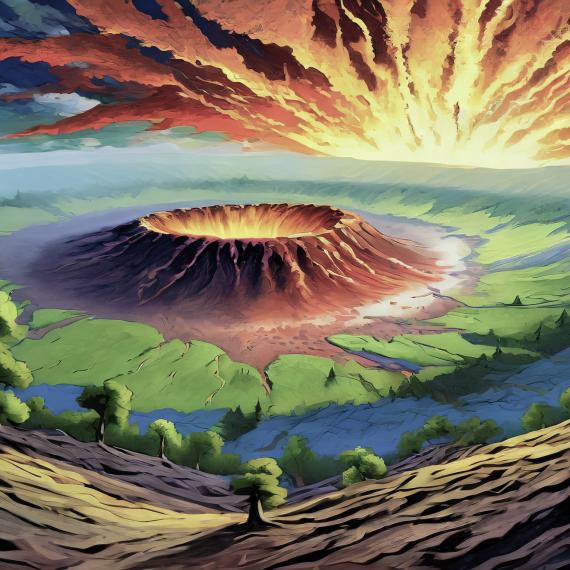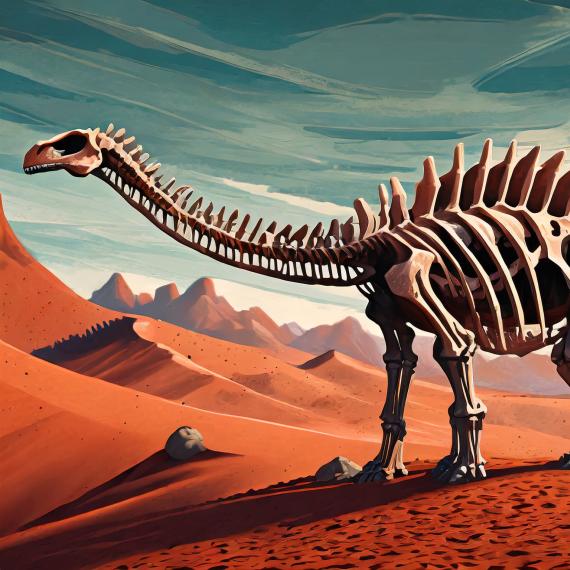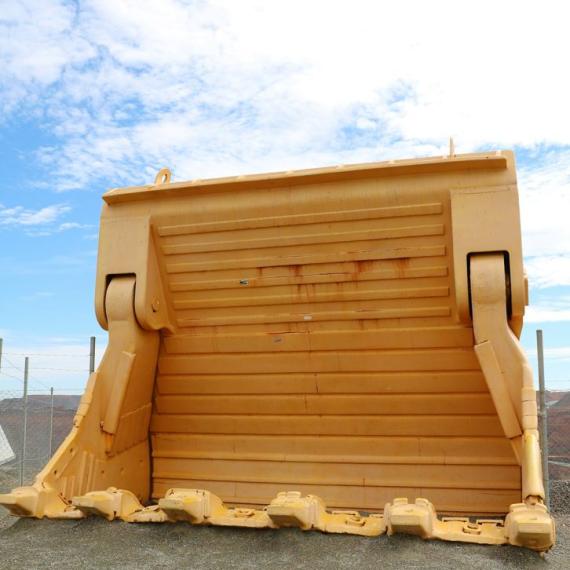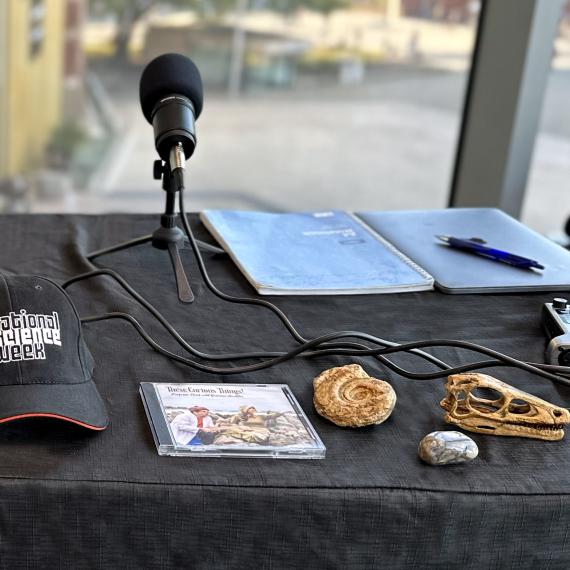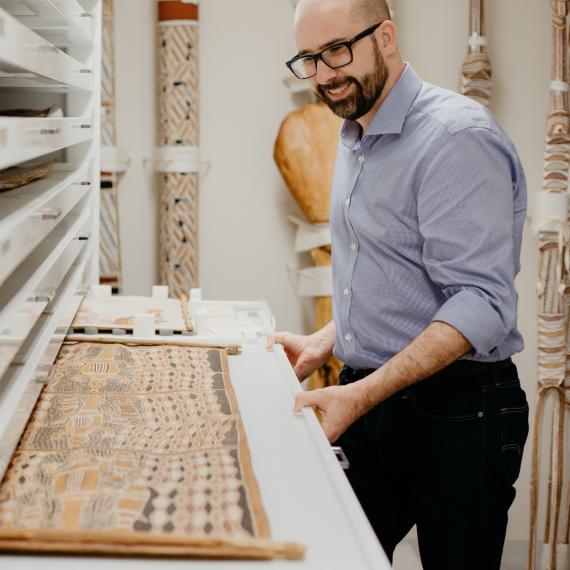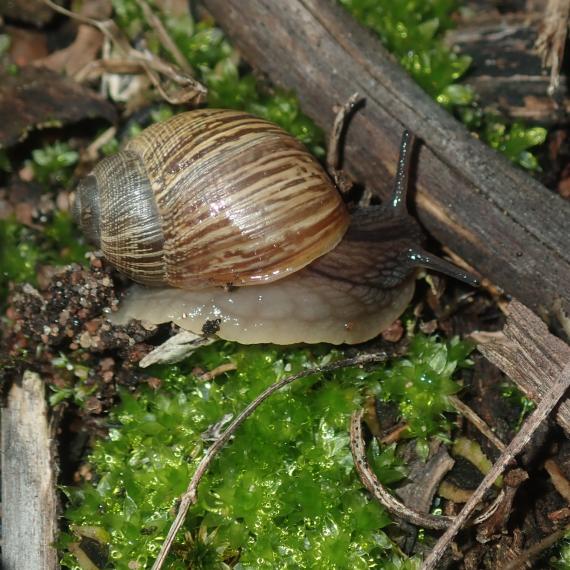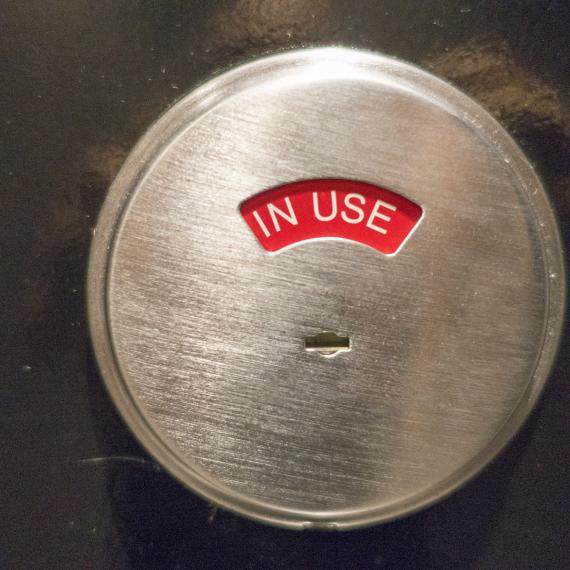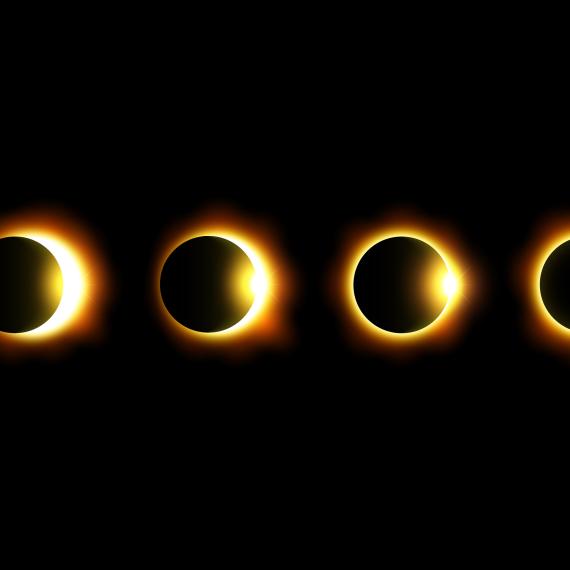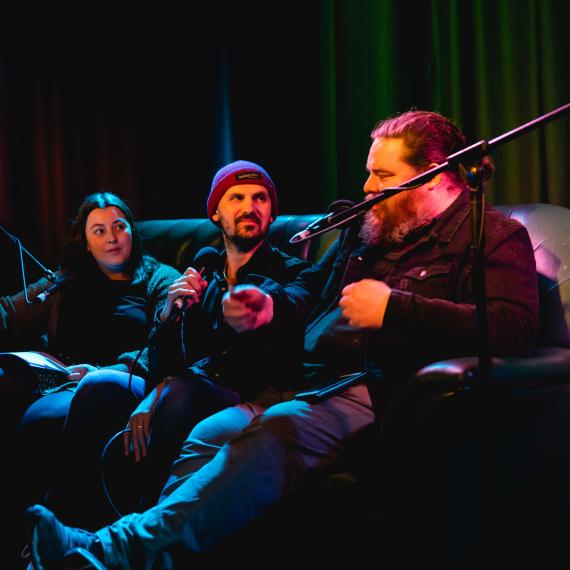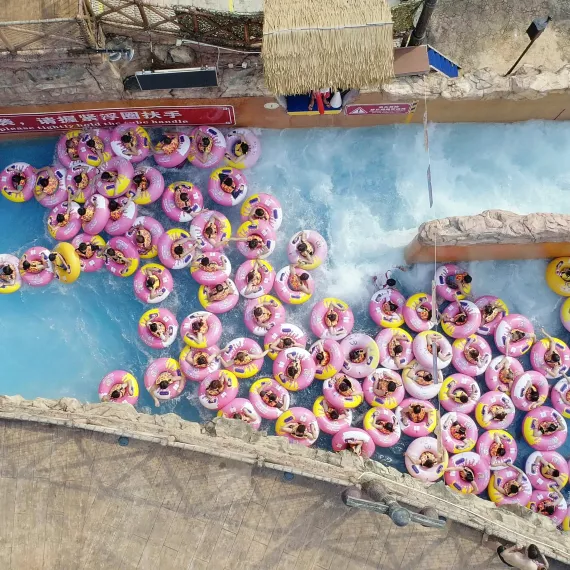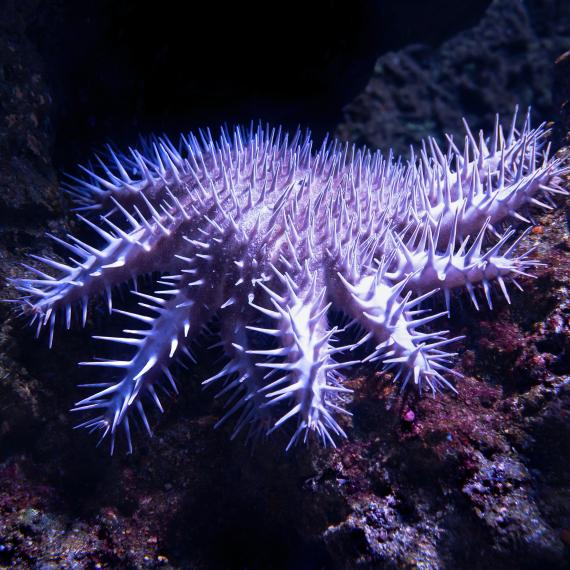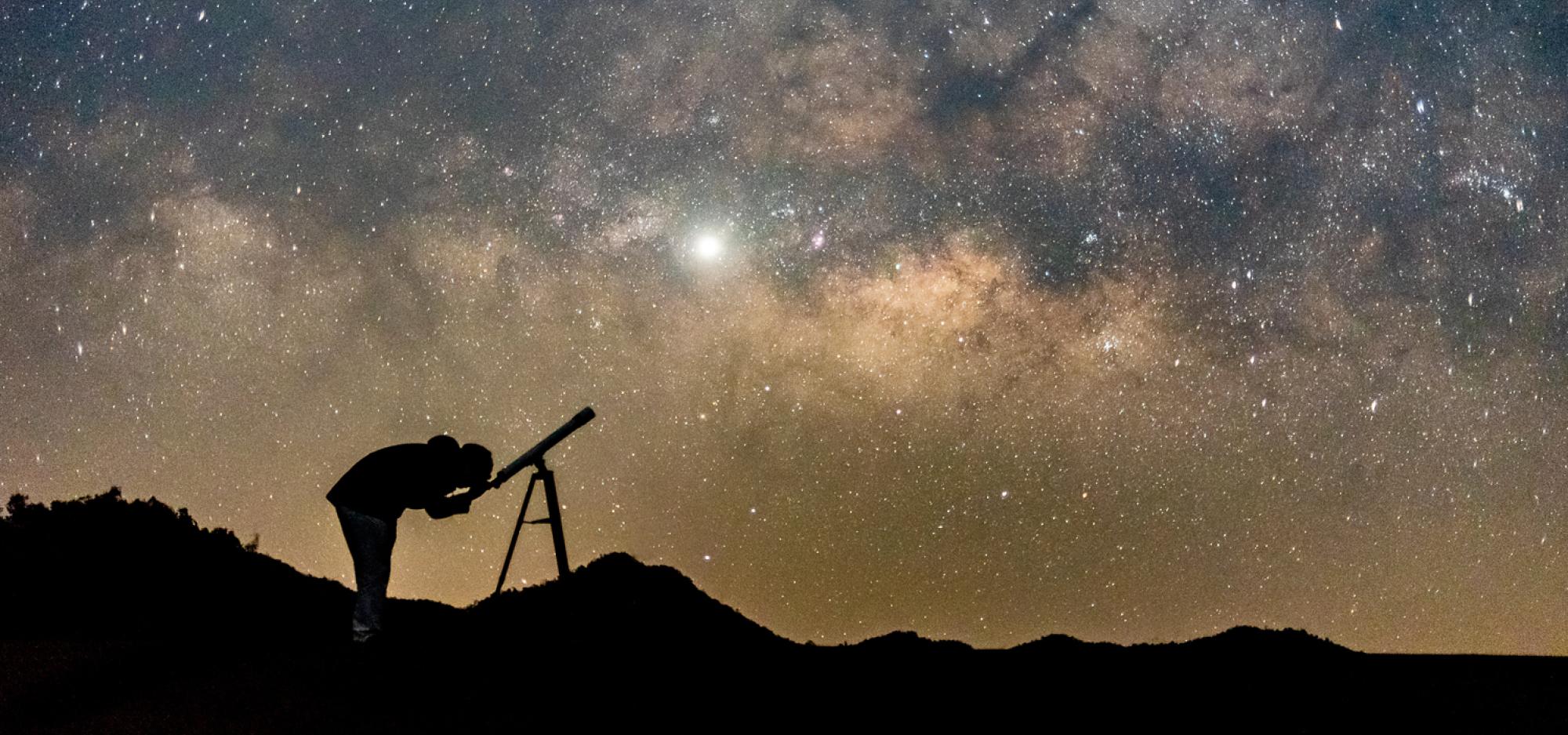
Astronomy Tools: Then and Now
Join us for a talk with Aristeidis Voulgaris to hear stories from his eclipse chasing travels and discover the complex instruments and tools used in solar astronomy.
Aristeidis “Aris” Voulgaris from Thessaloniki, Greece, is an eclipse chaser, travelling the world to experience solar eclipses. From the total solar eclipse in Kastellorizo, Greece in 2006, to Antarctica in 2021 and most recently in WA’s Exmouth on 20 April 2023, he has been there recording and studying eclipses with complex instruments that he has created himself. Aris is leading the FRAMe Project - The Functional Reconstruction of Antikythera Mechanism in Greece and has a strong interest in the tools used in Archaeoastronomy.
Coming back from Exmouth with his team of astronomers, Aris stopped off at WA Museum Boola Bardip to share his first impressions and scientific data from the total solar eclipse, his experience with contemporary eclipses and his knowledge of the instruments used in astronomy in antiquity and nowadays including the history and the purpose of the Antikythera Mechanism - an intricate device created in ancient Greece around 200 BCE.
We were also joined by Professor Xenophon Moussas via video link to give an introduction to the Antikythera Mechanism. Professor Xenophon Moussas is a Professor of Space Physics at the National and Kapodistrian University of Athens and is one of the founding members of the initial academic team of the Antikythera Mechanism Research Project (AMRP)
Listen to this talk to gain an insight into the Astronomy of solar eclipses and solar activity and have the opportunity to understand instruments and tools used then and now.
Have you ever wondered how scientists can calculate the exact dates of an eclipse? This talk took place next to our temporary exhibit Reconstructing the Antikythera Mechanism. This exhibition delves into an intricate device created in ancient Greece around 200 BCE—the Antikythera Mechanism, also known as the world’s first mechanical computer. Its estimated 69 gears performed complex mathematical calculations to predict the location of the sun, moon, and planets. View a working replica of the mechanism and learn more about the extraordinary story—from its chance discovery in a shipwreck to the modern scanning technology that enabled a replica to be made.
This program was organised in collaboration with the Greek Consulate.

-
Episode transcript
Transcript
Astronomy tools then and now
Alec Coles: Good evening, ladies and gentlemen. Welcome to this evening's event. Kaya. Wanjoo. Kalispera. <Speaks Greek> I am Alec Coles, CEO of the WA Museum and clearly not a native Greek speaker. <laughter> Welcome to the talk, ‘Astronomy tools: now and then.’ Firstly, as I always would on such an occasion, I want to acknowledge that we're meeting on Whadjuk land, the land of the Whadjuk Nyoongar people, and I acknowledge them as the Traditional Custodians of this land, and in doing so I pay my respects to Elders past and present. ‘Boola Bardip’ means many stories in Nyoongar language and this is a place of many stories both today and over many millennia. It's wonderful to see so many of you here tonight. Thank you for your support and enthusiasm.
And I would like to just acknowledge a few special guests this evening. Firstly, of course, the Consul for Greece in Perth here, Georgia Karasiotou and her colleagues. The museum has an important and long-standing collaborative relationship with the consulate and we've partnered on many things, not least the exhibition over there that I’ll mention in a minute. I also welcome the Consul General of Indonesia, Listiana Operananta. Tonight's speakers, eclipse chaser Aristeidis Voulgaris and, via video link, behind me here, Professor Xenophon Moussas. Aristeidis, or Aris, is from Thessaloniki and has travelled the world to experience eclipses, from Kastellórizo in 2006 right up until Exmouth last week. I was just saying I remember the 2006 eclipse because I was actually in Areopoli in the Peloponnese when it happened, which was a little way from Kastellórizo but, as my Google told me, only about three quarters of the way it is from Perth to Exmouth. So, I was actually nearer than— Professor Moussas is a professor of space physics at the National and Kapodistrian University of Athens.
Also joining us tonight, hiding in the back row there, is Western Australian engineer Dr Nick Andronis, whose—yeah, yeah, hey, give it up for Nick <applause> —whose extraordinary—it is extraordinary—working bronze replica Antikythera mechanism is the centrepiece of the exhibition over there, that some of you were just viewing beforehand and will be able to view afterwards. It's another collaboration with the consulate, and again, I thank you for your assistance with that. And somebody did ask me how long it's on for and it's on until September in the corridor there, but after which the model itself will be united with other exhibits down in our Innovations Gallery down below. So, really excited about that and delighted, Nick, you can join us. And so now to introduce tonight's proceedings, and somebody who really can speak Greek, can I welcome to the stage Consul Greece in Perth, Georgia Karasiotou.
<applause>
Georgia Karasiotou: Thank you very much Alec, and kalispera, good evening distinguished guests, fellow members of the Consular Corps and ladies and gentlemen, boys and children, because there are also younger ages amongst us and that's very encouraging. So, it is a great pleasure for me to be here today, both because of the exhibit, as you said, Alec, that is here since 25 March and for the event today. The stars aligned very well for it to happen. <laughter> I thought about it and I thought it would be <laugh> So, yes. I mean, products of the Greek, ancient Greek intellect and culture, are exhibited worldwide. Not always, admittedly, with our consent but here <laughter> we're, we're very, very proud to, to have this, this exhibit. And it's very fitting for WA because WA, it has one of the most spectacular skies that can anyone can see anywhere. So, it is so nice and we're thankful to Dr Nick Andronis for his long year research and hard work, and giving us the opportunity to find out more about the world's first computer.
So, as for tonight, and as I said it was a very good opportunity to, to do something around the exhibit, and it coincided very well with the eclipse and the, the arrival here of a Greek team who happened to know a lot about eclipses, but also of the Antikythera mechanism. So, we'll have the chance to, to find out more today about a theme that fascinated ancient civilisations, as well as now: the sky and the sun. Alec already said a few things both about our two very special speakers today, both Professor Moussas and Aristeidis.
I will just add to it that Professor Moussas is one of the founding members of the academic team of the Antikythera Mechanism Project, which is a research project, an international collaboration of academic researchers supported by some of the world's best technology companies and aims to completely reassess the function and significance of the Antikythera mechanism, which has been a mystery for many, many years as to how it works and what it does. The project is under the aegis of the Hellenic Ministry of Culture and has received strong backing from the National Archeological Museum in Athens, where, as you know, the original fragments of the mechanism are held. And I would say that he is one of the most representative and global advocates of the Antikythera mechanism, Professor Moussas, having put together and contributed to exhibitions, amongst others, for NASA, UNESCO, etcetera.
Now, as for Aristeidis Voulgaris, you will allow me to say that he's quite a character. <laugh> I, I had the chance to, to meet him a few weeks before the eclipse and I will just say that his profession— He's like a violinist, violinist of the Thessaloniki City Symphony Orchestra. So, that's what he does as a day job mainly. But he has been a passionate physics lover—and you will allow me again also to <laugh> to, to say the story that you said about almost poisoning your dad when you were young, young, very, very curious student, when he tried to experiment a bit with a casserole and an old mercury thermometer which burst into the casserole, which his dad then tried to eat. Luckily, <laugh> he found out and, you know, he prevented him from tasting it.
Aristeidis Voulgaris: [inaudible]
Georgia Karasiotou: 120 degrees?
Aristeidis Voulgaris: [inaudible]
Georgia Karasiotou: It’s okay. I think the whole batch has been destroyed and we don't use them anymore because of that. <laugh> So, yeah, he's been— This one has been his thirteenth eclipse, if I'm not mistaken. Right? Twelfth. Ah, not the thirteenth.
Aristeidis Voulgaris: [inaudible]
Georgia Karasiotou: Ah, okay, because I was preparing another joke about it being the lucky one, you know, despite being the 13th. But anyway, <Aristeidis laughs> for the next one. So yeah, he has been actually constructing the instruments that he has been studying the solar eclipses with himself, and he drew the attention of NASA, which used one of his instruments as well for the eclipse in 2017. And he also happens to be the head of the FRAMe project, which is the Functional, ah, Functional Reconstruction of the Antikythera Mechanism project in Greece. So, we can hear two things that are very interesting from him. And without further ado, I'll just pass the microphone to Professor Moussas and Aristeidis for the interesting part of the talk today. Thank you.
<audience applause>
Xenophon Moussas: I am very honoured, very glad to be with you this evening to present to you the oldest known computer, which is a mechanical cosmos and engineering dream, we could say, then and now. I mean, at the time, it was made probably some 22 centuries ago based on mathematical physics, in fact. So, this mechanism that you can admire at the museum in Athens –and we'll see in a while a couple of photographs from there—is the only example of, no doubt, many of them that existed in the antiquity, because we read the ancient books descriptions of them, that— These descriptions were believed to be just imaginary things given by the various authors. But the existence of this instrument in the museum, now in Athens, the National Archaeological Museum— And you are very welcome when you come to Athens, do send me a line email or make a telephone call and I can take you to the museum to see it on the spot.
The work I'm going to describe is the work of many people. Some of them appear on the screen now. Well, before anything, I would like to, to thank the museum, the director, of course, the consulate of Perth, and every one of you that we are now together. I have to express my thanks with pleasure always to the colleagues that have contributed to this work. And here I will also [thank] our technical team. And the secret is always, today, collaboration because you cannot do research without it these days. We have been very successful and these beautiful graph appeared only yesterday in one of the Greek newspapers of a mother 20 something centuries ago, complaining that her son is continuously with this tablet called the Antikythera mechanism. And in fact, I have to tell you that some 15 years ago almost, I discovered that the Greeks call, at that time, these type of instruments ‘tablets’. Pinakída[?] in Greek, in fact. And thanks to our research— Of course, we have followed the research to that very many people have performed very successfully in fact, given the circumstances, since 1907, 10, 1930, and so on, we have studied and we have continued in the roads that they have opened.
But with all these studies and especially the last one, now I believe the world knows that this mechanism made of gears some 22 centuries ago can predict astronomical phenomena, natural phenomena, based on the notion of causality always, and that nature's language is mathematics. Mathematics, in the sense that the laws of physics can only be expressed properly with the appropriate mathematics. And this is what this mechanism does. So we have studied with X-rays, taking something like 5000 radiographs combined appropriately with the appropriate mathematics and physics, we reconstruct the interior, the interior of the mechanism, and we know, for example, that this is the gear of the sun and there is a … system. Aris will talk about it very carefully in a while, I'm sure, because he has discovered quite a lot with his team.
And that's how we are here today to tell you that this double-faced clock, sort of, shows the position of the sun and the moon. It has an extensive manual, although we only have a small part of it, and even the existing one is very fragmented, but it is a compendium of astronomy. It tells you what to expect to see. How the planets move around. So it contains all the laws of physics as they understand them at the time. And it is programmed with gears, gears very carefully designed to perform divisions, multiplications and turn pointers like the one of the moon and the sun. And the moon changes speed as it goes around the Earth. So it really follows Kepler's second law, at least, if not all the three. We’re not certain yet, or at least I am not. It changes realistically, faces and speed as it goes around the Earth, following the observations that they already had at that time, the Greeks. That at the perigee it goes faster and much slower at the apogee. And the other, the other face of the mechanism has several dials that predict the eclipses as we can see at the bottom.
And of course, you can see the excellent exhibition that Nick and the Museum have set up for all of us. And I thank, I thank them again. And you will see there that it predicts when, for example, the Olympic Games will start and not only all the other important games that the Greeks have in the what is the phase of the moon today or what will be next month using a periodicity that today we use for Easter, Passover, and also for the Buddhist calendars. Various variations of these same lunar 19 year cycle. As I said, it is based on mathematics. And for these I dare to say that it is the epitome, the best example of Greek philosophy, and in particular the philosophy of Pythagoras and his disciples, the Pythagoreans that, according to Greek story, are the first to say that nature's language is mathematics.
So, when you come to Athens, you will see this exhibition. We can go together there. I can explain to you in more detail how we managed to see the surface as we see it here using again several— 40 photographs, in fact, for every part of and face of the mechanism, the fragments. We take off the rust using mathematics, in this case, and we can see the moon, how it goes around and read much better the manual. And of course, to see the inside and all. And I suppose that my 10 minutes have finished so we can stop here and I can assure you that the mathematics, the way this mechanism has been constructed, the laws of physics that it uses, are exactly the same, the, the same with the ones we use today, for example, to transform my voice to bits and bytes that come to you and you can listen to my voice and see these images using 32 terms exactly the same as the ones the constructor of the mechanism has used for the motion of the moon. And with this, I hope that you have already a taste of what this mechanism is and why I say, I dare to say that it is the epitome of those philosophers using mathematics to describe nature and understand the world. Thank you very much.
<applause>
Aristeidis Voulgaris: I’m Aristeidis Voulgaris. Thank you. I thank the museum, ah, Western Australian Museum for the invitation and I will present two, two things that there is a very strong connection between them. The one is the Antikythera mechanism and how it's constructed and the tools used by the construction of the, for the construction of the Antikythera mechanism. And, of course, the total solar eclipses. [The Exmouth eclipse] in Australia was my 12th. And believe me, if you, you see one eclipse, probably you will see to the next eclipse in the US. I will present you, I have a lot of images, so whenever I have any parts with a lot of words, I will come to the next very fast. We have, we’ll present the Antikythera mechanism and of course some of my experiences from the total solar eclipses. My first solar eclipse was started in 2006 from Kastellórizo. <laughter> There are three plates here from Egypt in different eras. On the left is, was constructed at about 700 BC, and the middle about 600 BC, and on the right at about 30, 30 BC. As you can see on top, there is a solar eclipse, there is an eclipsed sun, you can see here, with the solar corona.
These three plates were the, the official documents of Egyptian state during antiquity. So a solar eclipse was, it was very important for the ancients, for many reasons. I will tell you why. Babylonians, Egyptians, ancient Greeks’ astronomers, they knew the period of the, of the repeated eclipses. In Greece we have a lot of, many data concerning the observed solar eclipses during antiquity. The witches of Thessaly, Aglaonice—Aganice usually in the English language—was the daughter of King Hegemon, could be, could predict the lunar eclipses. Of course, it was not witch. Probably [she] knew something. Also Thales or Thales of Miletus predicted the eclipse of 28 May 585 BC. Very firstly, the geometry of a lunar eclipse. Of course this scheme is not on scale. At the left is the sun and the centre is this and that is the Earth and behind air, inside in the Earth's shadow exist the moon.
So, the moon will have a, a lunar eclipse in this position. Geometry of a solar eclipse. Of course, the moon returns, perforated around the earth, and there is possibly the, the sun, the moon and the Earth to be in one straight line, but not exactly. It is not necessary to be exactly in straight line. If, if the eclipse is not, if the position of the moon is not in straight line between sun and Earth, the eclipse will be visible from two northern parts or from the two southern parts. As we know, the moon is not constant, array, a distance from the around the earth. So sometimes approaches the earth and some times is located. Look, it's far away from the earth. This phenomenon, this effect, can be measured in the sky because when the moon is far away, moves in the sky too slow. And when the moon is closer to the earth, the moon travels in the sky faster. The difference between these two velocities, it's about 16 degrees per day, up to 11 degrees per day. So, the ancient Greeks, Babylonians and Egyptians could measure this variation. So, if the moon locates its, is located far away from the Earth, this position, this condition named apogee is a bit smaller than the angular, ah, diameter of the sun. So when it came on the straight line, the moon cannot cover the full of, the full of the sun. So we have in this condition, we have an annular solar eclipse.
During an annular solar eclipse, we cannot see the solar corona because the sun is extremely, extremely, too bright. In the above condition, when the moon is close, closer to the earth is a bit larger than sun, so can cover all this. So, all of the sun disk resulting a solar total solar eclipse. The light drops down and we can see the solar corona, stars in the sky. May I ask if someone here observe this eclipse in Exmouth? Okay. One, two, three, four, five, six. Oh, <laugh> okay. There is another condition. The moon is not in at apogee and is not a perigee. It is in the middle distance like it was the eclipse in Exmouth. So in this condition, the eclipse is named hybrid every year eclipse you because on the beginning starts as annular. After a bit the earth rotates and a bit is the distance closer to the moon. So it's a total and at the end of the eclipse, it is as an annular solar eclipse. We have a problem with the moon. Many problems. <laugh> As you know, yesterday we have lost the spaceship after probably was not landed in the, in the moon. So the problem is moon. <laugh> The moon is not there is not rotate, ah, the orbit of the moon has an inclination of five degrees. So in every month we have not solar eclipses.
If we had if the inclination of the lunar orbit was zero, like the orbit of the Earth around the sun, probably the solar astronomy would be revolved to yearly, one today. So you can see the difference on the lunar orbit. In this condition, the moon is projected above or below the sun, and only two conditions, here and here, is on a straight line. So, I have described the hybrid eclipse, and during Hellenistic era, the ancient Greek astronomers, Babylonians and Egyptians, they knew for cycles of the moon. The one is this, you know, the cycle from new moon to new moon. The second very important is that iconic cycle. When the moon base is from the ecliptic, the animalistic cycles is the variable, the velocity of the moon. So one animalistic cycle is from apogee to the next apogee. And this is arial, when the moon returns to the same constellation. And now, we starting the story about Antikythera mechanism. Here is the island Antikythera and the words, the name Antikythera mechanism because it was found in a shipwreck off Antikythera Island in Kastellórizo is somewhere there, I think. And after 2000, probably about one hundred, ah, 78 before BC, it became a Roman, a cargo ship named Orcas, probably it was travel to the sea bottom to Antikythera, at the Gulf Sea bottom. And 2000 years after about... 1900.
So, it sponsored divers. They found some a lot of things about the, this shipwreck. You can see here is a lot of many statues from Antikythera shipwreck, but most of them destroyed because of the seashells, sea salt, organ, sea organism, etc. This, this diving suit is named scafandro. I s, of course, too difficult handle or to swim with this diving suit. And one of the most important statues, the Antikythera Youth, here is in fragments. And after they, they assemble these fragments into a perfect statue, probably there is possibility some, someone keeps the Medusa's head or Paris keeps the golden apple from Asperides. We don’t know. The same problem of the sea, the sea organism affected and probably destroyed a lot of statues. And the Antikythera mechanism today is exhibited in the [National Archaeological Museum of Athens] in Greece, and unfortunately, it’s preserved in fragments. Here is all the fragments that, today, preserved fragments of the mechanism. A large number of these we can assemble between them, but many pieces missing.
Probably up today the fragments were applied the conservation, but with the conservation was destroyed a lot of information such as the inscriptions. A large number of words was written in the Antikythera mechanism bronze plates. Fragments were probably before the first conservations around 2001, in the beginning of the last century. A photograph of [theirs] and one of mine, you can see the difference of this conservation. And why this material is green? The name of the green bronze material is named verdirgris from the name vert-de-Grèce, the green colour of Greece.
In our team we started to, we had the idea to make a simulation regarding the corrosion of Antikythera mechanism. What suffered the Antikythera mechanism the first 100 days when it was sunk on the Antikythera bottom. So I was, we was to use an artificial sea salt. But the table salts for cooking is not original salt. They had something other. So we tried to find an original salt and finally we found sea salt from Kythera. It's too close. It's about 40, 50, 70 kilometres far away from Antikythera. So we had the original laboratory sea water for our experiments, so we took some pieces from bronze in the same alloy as the Antikythera mechanism. Bronze mostly is copper. The difference between copper and bronze is about 94% copper and 6% tin. Only 6% of tin make a strong change of the copper. Usually the metal of copper is like <speaks Greek> <laugh> It’s like, I don't know. <laugh> Okay. But by adding 6% tin in the bronze, the new material, the bronze changes. It is very hard. So it's ideal for process and gear making and in other material in other instruments. <audience member speaks> Yes. Yes. The copper is malleable. Yes. Yes. It's, ah, [inaudible].
Finally you can see, the fifth day, and after six months, what is going with that? The Antikythera mechanism is sandy, inside the seawater. Of course, we keep the salinity with the same value as the Antikythera mechanism sea bottom. Here is an experiment, very interesting, when … you can see two pieces, two same pieces. One piece is parallel to the sea bottom and the other piece is perpendicular. But they were not suffered to the same corrosion. So, we found that the corrosion of bronze by the sea water depends by the position of the material relative to the vertical line of gravity. So, here is the answer, why all the bronze statues were found inside the sea, they have not the same corrosion everywhere. But there is a very satanic material, evil material, named Chloride. Of course, you can see on top of this material, of this bronze blade, the corrosion is only at the edge of this material. But after two years, the corrosion evolves to all of the bronze. So, this was the answer, why the Antikythera mechanism today is not bronze material. It's something other. I would tell you what.
A random break. We found that a random break in Fragment A. You can see here, it's very deep inside the area of the Antikythera mechanism artefact. Now, there is not any piece of bronze. All of this material was transformed to a new material named Atacamite. Atacamite, this from Atacama Desert, because this material was found in a lot of amounts in the Atacama Desert. So, we have a material— T e Antikythera mechanism today is not bronze, it's Atacamite, a different material, with different density. The bronze has 8.8 cubic, 8.8 grams in per cube, per cubic centimetre, and this material here is about 3.8. So, we have changed the material. Change in density and change in volume. This volume is not the perfect original of the Antikythera mechanism original bronze material. So, this change. You can see that the fragments or especially the Fragment A is suppressed, distorted, deformed. And of course, there is a decline by the originality of the nuclearity[sic], etcetera, and is distorted in three dimensions. So, precision measurements, okay, we can make precision measurements but they are not the original measurements.
I know the Antikythera mechanism also preserved a wooden piece, like here. You can see 2000 years under water and preserve the wood? Impossible, yes. But copper is antimicrobial material. Destroys any organism who approaches an area with copper. So, very good, it was too close to the bronze copper material of the mechanism and the organism could not eat the wood. This, our work, of course, was published in the Journal of Coastal Research.
And of course, Professor Moussas told the story of the new research of the Antikythera mechanism. And I can show you now the difference between the visual images of the fragments and the X-ray on the right. On the right, this is the X-ray imaging of the Fragment A. You can see inside, that deep inside there are some gears. And of course, in the visual image, we can show or can observe only the outer parts of this fragment. The same story here. You can see small holes in the circular distribution. I will show you later. Also, Fragment B, the difference between visual and X-ray, and what we know now with, save, about the Antikythera mechanism, could predict, could show the position of the moon and the sun on the zodiac sky; the phases of the moon; the calendar; also the time of the athletic games beginning; and also could predict the solar and the lunar eclipses.
The Functional Reconstruction of the Antikythera Mechanism, the FRAMe project, the members, I am, of course me, the others, Christophoros Mouratidis, and Andreas Vossinakis. As I informed in the, in ten days from now, we‘ll be published our eight publication, eighth work in— My, one of our models using exclusively the four reserved tomographies. Here is one of our models, functional models. You can see that the small sphere here is black because is close to the sun in the same position. So the moon is new moon. You can see also if I turn around the input, according our opinion and for many mechological reasons, when the moon aims to the sun is black, and when the moon is in opposite position is white, because it is full moon.
We know the name khrúseos sphaîra, “golden sphere”, the sun is not preserved on the today fragments, but there is preserved on the instruction manual of the mechanism, the name khrúseos sphaîra, golden sphere. Of course, implies the sun so, we adopt golden sphere, sun, on the Antikythera mechanism. The back blade, there are two spirals. On top there is the Metonic calendar of ancient Greek calendar and on bottom you can see the eclipse prediction. How was begun the eclipse prediction? You can see some letters inside on the cells. For example, there is the letter Sigma, Greek Sigma here and the letter 'eta’. And another symbol like Angola[?]. When the pointer aims to this cell, the number sigma means Seleni. We have in this month a lunar eclipse and when the letter is eta, that is He, Helios, sun. We have a solar eclipse. So in this cell which is in the same month— it’s cell equals one month— In this cell will occur a solar eclipse and the lunar eclipse. But in ancient Greek calendars, first day of its month was right after the new moon and full moon, it was exactly the fifteenth day. So the lunar eclipses occurred in one day, every time in fifteenth day or fifth month. And then the solar eclipse was occurred the very last day of its month. Saros cycle, this was a period they probably statistical, firstly statistical and now we know what is going with this Saros. Every 18 years, 11 days and 8 hours, the solar and the lunar eclipses repeated from the beginning. So here is a part of the eclipse in Kastellórizo. It was in 2006, 29 March at 2.00 o’clock. If we add 18 years, 11 days and 8 hours, we the date 8-9 April at 10.00 o’clock on 2024. Okay. 10.00 o’clock of the sun of Kastellórizo rise so we must travel west, westward in order to observe this eclipse. This eclipse will be visible from the US and Mexico on next year and is one Saros after Kastellórizo eclipse. My first eclipse.
Our team also applied some, constructed some software in order to increase the contrast of X-ray tomographies and radiographies. On left, you can see the original X-ray from Fragment A and on the right our processed image. And of course you can see the high contrast. Here you can see an area. Let's increase this. This area, we found that the ancient manufacturer, probably he made the whole of the gear a bit larger so the gear was moved in his axis like this, very … this. So he applied this small copper, piece of copper in order to stabilise the gear on the axis. Of course, this creates some problems on the mechanism functionality. Also, we enhanced the boundary of the parts on the X-ray. You can see the boundary of the destroyed teeth of the gears and some other formations. [Andronis], he took the one piece of fragments, and reconstructed applying symmetry the parts of the Antikythera mechanism.
Of course, you can see that it's preserved only this by applying symmetry horizontally-vertical symmetry were reconstructed the original part. Also we applied some 3D reconstructions for the parts in order to study the mechanical behaviour and also the adaptation of the original bronze. Professor Moussas he referred to that the mechanism. He has a special design in order to operate to simulate the lunar motion. As we said before, the lunar motion is constant. Firstly starts with low velocity, increase velocity, max velocity, and after decrease the velocity. By this system inside the Antikythera mechanism, we have this increase, the decrease velocity. Also, we use the computed tomographies in order to make 3D reconstructions of the parts. Of course, these softwares are very heavy and you get you need lots of power in the computers in order to return or change position.
Also, we took X-ray radiographies of our parts, original bronze is using the X-ray radiograph from … was in at a hospital in Thessaloniki in order to compare our bronze parts in X-ray to the original X-ray of the Antikythera mechanism. Of course, before the of the assembly of the parts and after many, many, many, many failures of mine. No …, no laser cut, no computer, no, no special design machine tools. Finally, we have constructed Antikythera mechanism. Here is the procedure in order to construct the triangular teeth of the Antikythera mechanism. <laugh> I'm laughing. Why? Because my metal, when, in order to try to cut some gear teeth, some here, teeth that have prime number, for example, 17. Okay, if I want to construct the gear with 24 teeth, it's easy. One the diameter 12 and 12. want the particular diameter is six and six and six and six and bisecting is three and three, three, three. Okay. But if you want to construct a gear with 223 teeth, which is prime number, this is a problem. Finally, six methods for this construction I said no science, no computer. The last teeth was every time shorter than all the rest. <laugh> Okay. You cannot make something from the beginning. The same disaster. After six methods, I found a geometrical method in order to divide a circle in prime numbers.
The Antikythera mechanism is also crown gears. Here is gears. This of the gears are the same plane, but this gears is perpendicular to them, to the plane of the gear. You can see a cone, a hole in the center of the axis. Here is very a very complex axis of K of E axis. You can see that the cross-section are square, after continuous are circular, and at the other side is pentagonal. We don't know why. If the two edges was square in square cross-section, the mechanism works perfect. We don't know why constructed this pentagon. It was a lot of, it's, of course much of work in order to divide pentagon after circular and after square and of course the centre of the this three cross-sections must be exactly the centre. You understand of course what is going, if is not the centre. The Antikythera mechanism, the manufacturer knew the problem of his gears. His gears is too thin, about two millimetres so cannot be stabilised on the corresponding axis. So he placed this formation acting as spacer in order to avoid the liberation of the, of the gear. We know also that the ancient manufacturers stabilise the gears by perpendicular pins. Here is the photograph based, of course, on the X-ray images of the fragment. You can see the pins here. And so, in this way, stabilise the gear on its corresponding axis. And by applying the minimum hypothesis would construct our functional model that we're using for our research and to know in order to construct the Antikythera mechanism, the ancient manufacturer was needed definitely special machines. It's not possible to construct the Antikythera mechanism with toy tools. You can see from rhapsody ten in the Homer Odyssey, Odysseus blind—the blinding of cyclops Polyphemus. Let's see what is going with the Greek, ancient Greek text: [Reads Greek.]
First, refers that the ol—That the wood that blinded the cyclops was from olive. Why? <pause> No answer? [Audience member inaudible.] The wood from olive is very hard, very strong, and, uh … [speaks Greek] And they call that, something the charcoal from olive you cannot, is viscous with water. But yes. [Audience member inaudible] Odysseus foresaw that the perfect wood is, for this job, is the olive tree. And then, he pursues … Homer refers to that he used the wood, and rotate this wood inside the eye of Polyphemus like a drill with belt. And of course, in the third, you can see that he refers, that he knew, Homer, that the iron, on hardening, can be by super heating and after, it is suddenly inside the cold water. So we know there is some tools and mechanology[sic] and material process in Homer’s Odyssey. Here is a hydria from Museum of Fine Arts of Boston. Museum of Boston, they send me the original images. So you can see a carpenter using a ... bow drill. What is a bow drill? You can see here there is a, there is a bow with a cord and something by rotating count— and pushing clockwise and counterclockwise. We found in order to calibrate this image, we found that the height of the ancient Greek soldier or around the era of this hydria 400 BCE is about 165 centimetres. So we calibrated this bow drill and we construct an original. Of course, functional. It’s not only for show. It's functional.
Um, another … depicts the same idea, the same story is the story of Perseus. King Acrisius, informed that from the [speaks Greek] … oracle. Yes. Sorry. That his, uh, that the son of his daughter, uh, will kill him. Will kill him. So he took that night and sent it to the jail. But Jupiter pays with gold rain and after nine months was born Perseus. Acrisius was not to to kill, to kill his daughter and, uh [speaks Greek] … the grandchild. [Grand]Son. Sorry. And he adapted inside the wooden box and said to the carpenter, “Close the gap.”
So we reconstruct this different ancient bow drill. Here is also a tension mechanism. And you can see now, I can show you the video. Here is the bow drill from hydria, Boston Museum. In this procedure, of course, this bow drill is 450 B.C. and the second, the second bow drill is, this is more complex design. You can see the cord and the tension mechanism is on the right, like this. And in this way, any drill can be done. This bow drill also, we detected this bow drill in Apollo … Damascus. It was technical instruction to destroy a castle. Fragments, as I said, in the fragment, there are about 365 holes. Each hole is 0.7 millimeters in perfect circular distribution. Um, okay. I'm very careful where I was divided in order to construct this, but before starting to construct, I make my <laughter> in order to avoid failures. And definitely, the Antikytheria mechanism manufacture definitely needed a lathe. [Audience member inaudible.] What, what are you saying now? Just a moment.
Here is a marble still of ellipses. It is a contract between this sanctuary of ellipses and the ancient turner. I can show you the name here, Elefsina. Now it's, the ellipses are most porous pieces, make parts for the columns. … It's five fingers in length. Here is the name [speaks Greek]. Is mostly from copper and the below refers the construction of the alloy, the metal alloy. It says: [reads Greek]. “11 parts of copper plus one part of tin.” And below refers to [readsGreek] … “Make it circular by using a lathe.” So we have a proof that the ancient lathe, uh, was real at the ancient Greek. Also, we found the same words about the lathe in many ancient Greek texts. And where is the lathe? Finally, we found an original proof that a lathe was in the use during antiquity, in the Hellenistic era, in Petosiris tomb. It was a Ptolemaic tomb. Petosiris was a high priest of the Greek-Egypt community. It's like European community, because after Alexander the Great, Egypt, Babylon, Greece, it was like today, the today European community. And we found— They sent— We ask a photograph and they sent, the German Archaeological Institute of Cairo, they sent an original photograph of the lathe.
It was a colour painted mural. You can see the two technicians working a— Vertical lathe is the name. Let's make better the image. From here we enhanced only the, this here and you can see here what is going. On right is the motor. A pulley with a cord. Is a motor without the electricity. <laugh> And on left is the turner. So we construct this lathe and we use it in order to construct one axis for the Antikythera mechanism. Of course, using drilling machine and lathe on axis of the Antikythera mechanism, construct in about, in about two minutes, three. And uh, of course, by using this lathe, about thirty-five minutes.
Here, you can see that I’m the turner, and Andreas the motor. Here is our ... lathe from … stone. And you can see that I have, using a file I can decrease the cross section of the rotating axis. Andreas is the motor, is right. [Audience member inaudible] We are in Iron Era. So it is easy, very, very easy to construct. I can tell you the procedure to make a file. You can superheat an iron, and by using a knife or something you can construct the file. [Audience member inaudible.] They could... [speaks Greek.] Melt. Yes, they could melt the iron because they had the bellow too. But they could not, but they could process by superheating an iron piece.
We found that, in order to use a lathe, definitely you need conical holes at the edges of the axis like, conical holes like these conical holes we found on the Antikythera mechanism. And also in axis, that you cannot see from the visual images, but on the side inside areas in using X-ray tomographies. We found from our research, uh, applying symmetry, that the numbered cells we reconstructed, we renumbered the... ah, measured, the number of cells. So by this correction, the first cell begins with a solar eclipse. Fragment is, a part of a fragment of Antikythera mechanism. Very enigmatic. Uh, here is the tomographies. The digital construction, and on bronze, the construction. We found that this, uh, this beam is distorted like this. And finally we found this, that this part could be preserved. Their fourth lunar cycle, the Draconic cycle, which is very important because it defines if an eclipse will be occurred or not. Um, also we found that that the Antikythera mechanism needs a date, initial date, starting date in order all the pointer pointers working properly. We found this date in 22, 23 December of 178 BC. And now, uh, I can show you the solar eclipses.
This is our Hellenic American expedition. In Australia was— … Jay M. Pasachoff, he was a very, very important astronomer in the US or around the world. He observed about 72 solar eclipses. Um, unfortunately we lost him on 20 November 2022. My first eclipse was in Kastellórizo. I have very good, uh, very nice memories from Kastellórizo, whether for the travellers around. Here, you can see also the lunar rising. Um, our telescopes. Uh, probably my, my comparison is a solar … Uh, this, I have travelled to these places in order to observe the solar eclipses and to capture the solar corona. Here is from Svalbard. You can see one of our images in polar aurora. And of course, I'm constructing the mechanical instruments dedicated in the solar corona spectral analysis. Um, some spectrographs can work outside the atmosphere. Um, its … lines.
I hit the ground from … lines in order to test some of my instruments with some special eclipse flights— Some special flights. Sorry. And to NASA on total solar eclipse 2017. They used my Icarus spectrograph. One of this instrument in order to analyse the solar corona during NASA's aircraft Z3. Thomas … a solar astronomer, who used my instrument Icarus solar corona spectrograph in order to analyse the solar corona. And after NASA flight, it was my turn to fly with an airplane above Antarctica in the last, before one year, about one year.
And here was our setup with three spectrographs and telescopes. The last, the flight was programmed with Boeing, ah, with an Airbus airplane. And the last, uh, the last time was changed to Boeing. So all this system was changed. And for the construction from the beginning. Here you can see the lunar shadow from very high altitude of about 12,000 meters. And you can see the lunar shadow in Antarctica in relation to Australia eclipse. From here, the images from satellite, you can see the dark spot crosses Exmouth and of course in the centre of the spot, it's the total solar eclipse. Here is our instruments and our team... <applause> Also Professor Tomoko Matsuo from University of Chicago, but [she] should be in university today so [she has] no time to be with us.
And I can show you also some images from Learmonth. You can see here, hydrogen breeds here. It's very characteristic. The name is chromosphere in this, this area of the sun. And one first of the results of solar corona by applying some mathematical process in order to increase the boundaries as the Antikythera mechanism. I guess, to increase the boundaries of its formation, the solar corona. And from an older eclipse, we know that the solar corona, it's very, very hot. It's about 2 million degrees and, or 3.5 million degrees. But up to now we don't know why. The surface of the sun has … about six thousand. So, the atmosphere gives … two million. It's ah, no logic in this phenomenon but this is nature. Ah, the spectrograph. I'm using the spectrograph in order to analyse the solar corona. And you can see some spectra, what's making the spectrograph. He spreads out the colours. They emit its colours from the sun and let's make a solar spectroscopy experiment. I have bring with me the spectrograph. So here is. Now you can see something, but if in my material it has specific characteristics. If I send the energy to a material to the atoms, these atoms react and protest by sending light to me.
So I have the energy here. I'm using sea salt and every time the sea salt is on the flame, there is an emission line from … that is from sodium. In this way we know that the sun and the solar corona exist, chemical elements like of course iron, which is ionized because the very high temperature also exists hydrogen, helium and sodium. Of course, here is our sun. When the sun is not eclipsed, the instrument is blinded, the camera, and by making a making in artificial eclipse, we can see the emission lines from the solar corona. This is a solar, this is the sun in the solar corona. By this procedure, we know, we can know what is the, which is the elements of the solar corona and of course the temperature.
It is the same procedure— Of course, here is the original spectra from Easter Island in eclipse 2010, from the eclipse 2015, ad here is our very, very new data. We have very good data from Learmonth in … We observe the eclipse in perfect conditions. Of course, another will be processed when we come back to, to Greece. While we're studying the sun. The name Anthropos means— It’s produced from the name, from the words, [speaks Greek], “look up to the sky.” So the first reason is we observe the sky and the sun because we are humans. But there are many other reasons. Here is Maunder Minimum in the era of 1650 up to 1720, the sun, the solar activity was zero. No sunspots. Uh, no explosions. No. No anything. In this era named Maunder Minimum, we found that the wood, the rings of the wood is too close between, uh, between them. So trees at this era was, not became well. [Speaks Greek.] They didn’t grow up— It was very, very poor. Poor. They grow up poorly.
Antonio Stradivari here, playing with, Antonio Stradivari, violin. You can see that there, lines here are very dense between them because Stradivari used wood from the Maunder Minimum area. After this area, the sun, the solar activity increases and decreases every 11 years. So there is, there is not a constant period of the rings. So now and you can see a simulation, of course, from NASA. Sorry. Here is an explosion in the sun, name of a flare. It collapses and, due to the explosion, sends material particles and radiation to the interplanetary space. There is possibility these particles, named solar wind, to cross the Earth. In this condition, creates the aurora and many problems to the satellites. Can be destroyed, the electronic system of the satellites. And of course to have problems in the telecommunications and internet.
Some here— I must finish my presentation. I want to thank the consulate of Greece in Perth for their help: we have many problems. Australia differs than Greece. We need the special permission to travel in somewhere in Exmouth. And finally, Mrs Georgia Karasiotou help us to select, to find the specific place for our observations. And of course, Kylie's family for the hospitality of our team during, uh, the solar eclipse of 20 April. And [inaudible] for, uh, their help about, uh, our equipment transportation. If we have, uh, if you have questions, probably we have time. There is time. <applause>
The next solar eclipses will be occurred in the US in one year, below one year from now, and 12 August in north Spain and uh, 2 August of 2027 in Luxor of Egypt. And of course, probably we visit for one time in 22 July 2028. This is the second large solar eclipse in Australia. Probably we'll travel north because we have the information that the weather will be better than Sydney. <laughter> Okay. Okay, and of course, the solar eclipses have a high interest from probably very deep inside time up, of course, up to today. Thank you and apologise for my English. Probably was medium up to terrible. <laugh>
Audience member: The solar flares, you mentioned that they occur periodically in eleven years. There is also 111 year cycle.
Aristeidis Voulgaris: Yes. But there are additional cycles for the sun. But when you increase this, the period, you have not many information. Um, probably there is a possibility to exist a solar cycle 1000 years but we don't know because solar observations started after Galileo Galilei. The constant solar cycle is the eleven years, but we found that, uh, this, this cycle had a gap from 2000 after Kastellórizo up to uh, 2019. With this, we observe different elements in the spectra that do not obey on the eleven, uh, period solar cycle of activity.
Audience member:There was a broadcast on the news about solar, ah, the northern lights … in the US.
Aristeidis Voulgaris: Yes.
Audience member: … solar flares. Is that unusual?
Aristeidis Voulgaris: A solar flare is an explosion and due to this explosion since, uh, material with these particles— But it is electrical, very high electrical voltage. Okay, it’s not correct but I'm sending to, to explain you. And when the electric field moves, creates magnetic field which interact with, uh, magnetic field of the Earth. So these particles increase their velocity up to 3000 kilometres per second and cross with, uh, oxygen and nitrogen atoms of the atmosphere. And this gives energy. So, the atoms of oxygen and nitrogen emits light. And this light is the aurora.
Audience member: It’s unusual for this to happen in the US, though?
Aristeidis Voulgaris: Ah, no, it's not usual. And usually if the flare is strong, you can see the northern lights close to equator. There are many information also observed from Greece, in Athens, Greece, some lights in the sky. And I don't remember exactly the date, but around 1770 occurred the most, the strongest flare were reported, which was reported up to now. And they observed aurora from Cuba. Now we have problem. It's the problem of the flares is really because all of our life depends on electricity, satellites, and internet. Statistically, there is possibility of a strong flare in the sun. And because now from this eclipse, we know for sure that this solar maximum will be, we are too close to solar maximum now. There's a lot of maximum— the eleventh, the peak, the peaks of every eleven years will be occurred about 2024-25. So we are, from our spectra, we know that that the barrage[?] of the corona is very high. Now it signifies that, signifies that we are too close to the solar maximum.
Audience member: One thing you mentioned … I’ve read that the wood that Rembrandt used was a very fine grain, oak, so it sounds like that wood was chosen from an era, from a time that the solar cycle was …
Aristeidis Voulgaris: Too many paintings during Maunder Minimum depict, if I understand it well, depict skating on the ice. Thames, during solar, during Maunder Minimum times— Thames, the river in London, was frozen and there are many paintings depicting the people skating on the ice and also market with potatoes, horses, etcetera, on Thames. Before and after this Maunder Minimum, Thames was not frozen.
Audience member: Do you know where the tin came from? [inaudible]
Aristeidis Voulgaris: This is very good question. <laugh> The mining, tin minings around the Mediterranean, there is not a lot. Probably there is possibility from Babylon or Armenia or, according to Homer, from ‘Cassiterides nisi.’ It's in South England. Cassiterides means ‘tin island.’ Also, Homer writes, refers as Cattiterides. The double ‘s’ is ‘t.’ Probably the possibility tin came from Cassiterides in the area of these islands in south of England. And for this reason, was too expensive; also copper and also tin. And probably there should be constructed many bronze Antikythera mechanisms, but it was very expensive and probably recycled as metals. And this Antikythera mechanism was survive because the ship … sunk in the sea bottom.
Audience member: I believe the Antikythera mechanism could only be afforded by very rich people? So, I think I read somewhere that the transportation ships that stop where these completed mechanisms were actually ordered by very rich people, as they were the only people who can afford those mechanisms. Is that true?
Aristeidis Voulgaris: Ah, the Antikythera mechanism had incorporated all the, all the time. Any calculation of time inside the machine. There is possibility to construct it—this is hypothesis, it’s opinion—to be constructed for a [speaks Greek] … in administration, for the time administration. In order, for example, when the sun is on the, is before one— [speaks Greek] And the second possibility—okay, it's not, uh, not publication, it's opinion—there is possibility that the Antikythera mechanism to use by an oracle like Dephi. [Speaks Greek.] Okay. I ask the oracle— The Athenians asking the oracle, “When I must fight, we must fight with Persians?” The administrator of the oracle, he had the machine and he knew that a lunar eclipse will be kept in two days from now, from the question. So to answer it— Usually the lunar eclipses are red. The moon is red, is red coloured. So, cool answer to Athenians: “When the red moon rises.” <laughter> “What is red moon? Why?” But after a few days Athenian soldiers, they observed that the red this moon during lunar eclipse rise from, rising above the horizon. So they start fighting the Persian. The other side, Persian, they saw that red this moon and the Athenians come to fight with us. Do you believe which is the winner, according your opinion? <laugh> We don't know.
Alec Coles: So, before you all run to the bar— <laughter> I did, by the way, love that your spectrometer is called Icarus. There's obviously a bit of irony there. There was a slide where you said Icarus flies with Aegean. <laughter> I thought that was better than flying with wax and feathers. But anyway, that's another story. Look, the amount of questions has indicated what an incredible amount of interest there is. What a wonderful evening. I think we've lost Professor Moussas. He's been closed down over there. But I would like to thank him. I would obviously like to thank all the support here, particularly from the consul here in Perth. But most of all, I'd like to thank Aris for an absolutely fascinating evening. Thank you very much. <applause>
You can bail him up after, as Ruth has said. There's also Nick who's hiding at the back there. Do go and have another look at the Antikythera mechanism recreated there. It's absolutely incredible. And as Ruth says, if you're quick, you might catch the bar. But thanks very much. Only thing we ever ask of these evenings is, go and tell everybody else about the exhibition and make them come in. Thank you. <applause>
More Episodes
A compelling discussion shedding light on the distinctive narratives of those openly embracing their HIV-positive status and what this has meant historically and in today's world.
Meet Professor Kliti Grice, the West Australian Scientist of the Year 2022, as she embarks on a quest to decipher the Earth's past mysteries.
Join a panel of featured young LGBTQIA+ writers and storytellers as they delve into the fantastical realms and real-world struggles of the exciting new anthology, An Unexpected Party.
Explore Australia's dinosaur legacy with Dr Stephen Poropat as we better understand the science behind the scenes of Australian palaeontology!
As we inevitably move towards cleaner, more sustainable forms of energy, how will a shift away from traditional mining practices transform this economy? A panel of experts explore the implications of this shift with a specific focus on how we see ourselves in a world that increasingly demands environmental responsibility.
Join Megan Krakouer, a prominent Aboriginal leader, as she discusses the nuances of her surprising change of heart on the Voice to Parliament — just a week before the referendum.
Join host Michael Mills in a captivating live recording of the Palaeo Jam podcast during National Science Week!
As AI rapidly evolves, join our panel of experts in an exploration of these complex issues, including how we can harness its power while ensuring responsible and ethical use before we're outrun by its speed.
Do you know how and why your teeth do what they do? Find out all there is to know about teeth sharpening.
Decoding the language of our written and oral histories in Australia.
Join us for an insightful talk with the esteemed Professor Henry Skerritt, as he takes us on a journey exploring the captivating art of Jdewat/Ballandong artist Meeyakba Shane Pickett.
No, it’s not a card game but a community initiative helping us further our knowledge of a group of endemic land snails Bothriembryon affectionately called ‘Boths’.
Delve into the way Aboriginal industry professionals are shifting representations, decolonising the media space and creating visibility for Aboriginal people in the industry.
Exploring the debate surrounding the establishment of an independent, representative advisory body for First Nations people.
Join a panel of experts and community as they investigate the nature of queer bodies, and queer sexuality, in public space.
Join historian Toner Stevenson and astronomer Melissa Hulbert, as they share their tips on how to salute the sun during this eclipse!
Simon Miraudo and Tristan Fidler from RTRFM’s ‘Movie Squad’ are joined by Chelsey O'Brien, Curator at ACMI, as they review and discuss Alice’s Adventures in Wonderland as a foundation for contemporary storytelling in film.
In this one-off Perth Design Week talk, the Museum celebrates the remarkable women in architecture and film in a panel discussion, recorded as a part of its recent award-winning film screening.
Join world expert Dr Chris Mah from the Smithsonian Institution as he recounts his encounters with some of the most unusual creatures on the planet.

